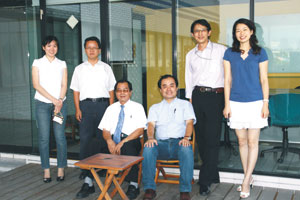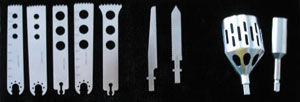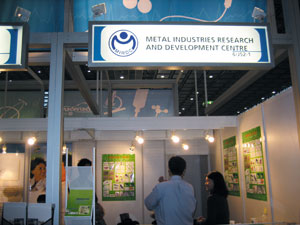MIRDC Helping to Sharpen Edge on Taiwan's Hand Tool Industry
2009/07/30 | By Steve Chuang
Despite the markets crashing around the third quarter of 2008 due to global financial tsunami, Taiwan's hand tool industry turned out NT$59.26 billion (US$1.808 billion at US$1: NT$32.76) of products in 2008, edging up 0.4% from 2007, with NT$55.76 billion (US$1.7029 billion) or NT$209 (US$6.379) per kilogram being exports, according to the ITRI (Industry & Technology Intelligence Services) of Department of Industrial Technology, under Ministry of Economic Affairs (MOEA).
However, the global recession has not spared Taiwan's economy in the first quarter of 2009: the hand tool industry's output value plunged 32.7% to NT$9.79 billion (US$298.84 million) from a year earlier, with a 32.2% decline in exports to NT$9.03 billion (US$276.14 million) in the quarter.
Overly USA-dependent
Besides the downturn, over-dependence on the U.S market has exasperated the industry's exports recently. After all, the USA has been seeing the worst recession since the 1980s, with teetering banks, collapsing carmakers, stunted home-building industry, all of which have fueled unemployment and sapped consumption. Despite diversifying markets, Taiwan's hand tool makers still exported up to 30% of output stateside in 2008, and 25% in the first quarter of 2009.
In addition, DIY tools no longer are guaranteed profit makers for Taiwanese suppliers due mainly to increasing underselling by rivals in emerging countries. Hence, the solution is to move upmarket in function and added-value, tapping advanced technologies to turn out digital hand tools, professional tools and international standard-compliant medical tools.
Fortunately for Taiwanese hand tool makers, the Metal Industries Research & Development Centre (MIRDC), a 46-year-old non-profit R&D organization that develops state-of-the-art production technologies for metals and metallic product industries on the island, has been commissioned by the Industrial Development Bureau (IDB) of the MOEA to carry out the "Metal Industries Competitiveness Enhancement Project" since 2007, helping Taiwanese metal product industries, including the hand tool sector, to further hone competitiveness.



Lin Wen-shush, senior engineer & special assistant at MIRDC and the project manager, says that the MIRDC, after extensive discussions with the IDB and industry insiders, aims to raise the production value of Taiwan's metallic product manufacturing industries to NT$820 billion (US$25.03 billion) by 2010 from NT$737.4 billion (US$22.51 billion) in 2007.
To make the most of limited resources to raise output value for Taiwan's technologically competitive and export-oriented sectors, the team has been focusing on development of the fastener, hand tools, surface treatment and valve manufacturing sectors, according to Lin. "Resources are purposefully poured into the four sectors from downstream to upstream production," he says. "The project aims to offer a total solution, from product development through technology upgrades and industry environment improvement, hopefully to double the average export price of Taiwan-made hand tools, for example, to US$10 per kilogram and that of fasteners to US$4 by 2010."
Improving Industry Environment
Improving the industry environment is no doubt the first challenge for Lin's team, as his teammates are required to analyze industry environments and build databases the first time. "It's not an easy job," Lin says. "For it takes time and experience."
With over two years of hard work on data collection and building database, the team has created an information reporting system, providing up-to-date information on international material and fuel prices, industrial technologies and useful knowledge for the government, which is enabled to always have a concrete understanding of the industry and global market, as well as set regulations and provide timely help for suppliers.
Another approach to improve the industry is to reduce brain drain from traditional manufacturing industries. Lin's team has been trying to build the labor pool by fostering more interactions between academia and industry, encouraging companies to adopt inspirational product designs and concepts proposed by students in production of marketable products.
Doing so, companies can build closer ties with future vocational and technical school graduates, enhancing the likelihood of recruiting such young workers. "Most of Taiwan's well-educated, young graduates prefer to work in electronics and IT (information technology) industries, hence depriving metallic product industries of quality labor," Lin says.
With key technology and value-added product development as the MIRDC's forte, and considering viability, marketability and technological advantages, Lin's team has helped various suppliers to develop over 40 value-added metallic products, including automotive fasteners, aerospace fasteners, micro fasteners for 3C (computer, communication, consumer electronic) products, digital tools and medical tools, which are regarded as major export boosters.
Also the team has pushed ahead the formation of alliances among surface treatment companies in Taiwan's central counties, helping them develop chromium-free and trivalent chromium surface treatment technologies, introducing quality inspection technologies and standards for automotive fasteners, building platforms for R&D and technology exchanges, and constructing databases on international standards.
"Eventually, the ultimate goal of the project is to enable most Taiwanese hand tool makers to move up to ODM (original design manufacturer) from OEM (original equipment manufacturer), and even to see some globally-competitive suppliers evolve into OBM (original brand manufacturer) in the future," says Lin.


Proof that the project has not been an academic exercise lies in the realization of mass production technologies used to turn out specialized surgical instruments, including reamers for femurs and tibias, bone cutter and saw blade sets and intramedullary nails for total knee replacement surgery, all of which have been jointly developed by the team and K&W Tools Co., Ltd., a veteran saw maker founded in 1973 in Taichung City, central Taiwan, says Lin.
"We have been interested in developing high-end tools that are widely used in hospitals in advanced countries, like the U.S. and Japan," Lin says. "In fact, Taiwanese makers have been able to develop such prototypes meeting FDA (Food and Drugs Administration) standards, but are still unable to set up mass production lines."
Lack of brand recognition is also a common problem for Taiwanese makers, Lin says, mainly because hospitals, especially ones in Taiwan, generally buy and use medical instruments labeled with globally famous brands, which are trusted based on familiarity. Subsequently, overcoming such hurdle has increased inertia among Taiwanese makers to go further to develop such products.
Mass Production Set Up
Coming to the rescue to help Taiwanese hand tool makers carve out a niche, the MIRDC came up with NT$1 million in financing, helping K&W Tools to fine-tune production machinery, apply stainless steel in production, and upgrade metalworking methodologies, all of which enabled the supplier to successfully set up mass production lines for the medical instruments.
Helping K&W Tools with marketing, as important as mass production, the team later pitched in to take the supplier to attend MEDICA, the world's largest trade fair for medicine and medical instruments in Dusseldorf, Germany, in 2008, helping the maker to meet foreign buyers and build a name at a global exhibition. Encouragingly, a few local, major medical centers are using K&W Tools' products on a trial basis.
As a creative way to help K&W Tools to build recognition and distribution, Lin's team has been promoting cooperation between the supplier and veterinarians in Taiwan. "This is feasible," Lin stresses, "because veterinarians are less restricted by regulations than doctors in hospitals. And yet they are using our instruments on animals with similar organs. We believe such opportunity, and feedback from real-world users, allows Taiwanese hand tool makers to enter the medical instruments market."
Despite having made significant progress, the MIRDC's work has perhaps only begun. With the project to officially terminate in 2010, Lin's team will surely kick off another 5-year program to assist metallic product industries in Taiwan to develop a variety of innovative, value-added products, Lin says. "Digital screwdrivers, digital power tools and special fasteners for wind power generators and oil drilling rigs are all on our R&D list for the next project."
Output Value of Taiwan's Hand Tool Industry | |||||
2005 | 2006 | 2007 | 2008 | Q1, 2009 | |
Total Output Value | NT$51.98 B. | NT$55.57 B. | NT$59.04 B. | NT$59.26 B. | NT$9.79 B. |
Year-on-year Growth Rate | 1.187% | 6.9% | 6.24% | 0.37% | -32.7% |
Export Value | NT$48.05 B. | NT$51.95 B. | NT$56.09 B. | NT$55.89 B. | NT$9.03 B. |
Year-on-year Growth Rate | 0.586% | 8.1% | 7.96% | -0.356% | -32.2% |
Source: ITRI | |||||




